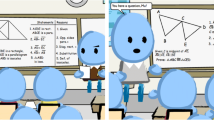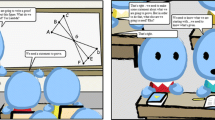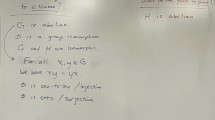Abstract
This paper compares task features and cognitive demand of proof tasks in two US high school geometry textbooks and considers how such differences influence geometry teachers’ facilitation of proof and students’ engagement with proof tasks during enacted lessons. Data were collected via interviews, task cover sheet-before implementation, task reflection sheet-after implementation, samples of students’ work, and classroom observations. Descriptive statistics were used to summarize task features and cognitive demands of proof within textbooks, and a grounded theory approach was used to analyze the enacted lessons. The results revealed variation in the nature of proof tasks within textbooks. Additionally, even though geometry textbooks may have higher-level demand proof tasks, there is no guarantee that such tasks would be assigned, or that the levels of cognitive demand of tasks will be maintained from the written to the enacted curriculum. Factors that can influence how teachers’ use textbooks include: beliefs, students’ disposition, and assessment. Thus, teachers’ actions can limit the extent students engage with proof. This study has implications for unpacking the complexities of students’ engagement with proof.

Similar content being viewed by others
Notes
Horizon Research, Inc. developed the artifact packet for the Cases of Reasoning and Proving (CORP) in Secondary Mathematics Project, with funding from the National Science Foundation (Award No. DRL-0732798). CORP seeks to develop curriculum that can be used for professional education that promotes reasoning and proving, and the development of mathematical knowledge needed for teaching.
The observation protocol was adapted from an instrument developed by Horizon Research, Inc. for CORP that documented how teachers use the proof tasks during the lesson.
The dates are read as month, day, and year, so 11-2-11 means November 2, 2011.
This is a standardized exam administered by the state, which assesses the state geometry curriculum.
References
Anderson, J. R. (1983). Acquisition of proof skills in geometry. In R. S. Michalski, J. G. Carbonell & T. M. Mitchell (Eds.), Machine learning: An artificial intelligence approach (pp. 191–219).
Bass, L. E., Charles, R. I., Johnson, A., & Kennedy, D. (2004). Prentice hall mathematics geometry. Upper Saddle River, NJ: Pearson Education, Inc.
Battista, M. T. (2007). The development of geometric and spatial thinking. In F. K. Lester (Ed.), Second handbook of research on mathematics teaching and learning (Vol. 2, pp. 843–908). Charlotte: Information Age Publishing.
Bieda, K. N. (2010). Enacting proof-related tasks in middle school mathematics: Challenges and opportunities. Journal for Research in Mathematics Education, 41(4), 351–382.
Boston, M. D., & Smith, M. S. (2009). Transforming secondary mathematics teaching: Increasing the cognitive demands of instructional tasks used in teachers’ classrooms. Journal for Research in Mathematics Education, 40(2), 119–156.
Chang, Y.-P., Lin, F.-L., & Reiss, K. (2012). Learning opportunities for mathematical proof: The presentation of geometry problems in German and Taiwanese textbooks. Paper presented at the 36th Conference of the International Group for the Psychology of Mathematics Education.
Cirillo, M. (2008). On becoming a geometry teacher: A longitudinal case study of one teacher learning to teach proof. Unpublished doctoral dissertation. Iowa State University, Ames.
Cirillo, M., & Herbst, P. (2010). Moving toward more authentic proof practices in geometry. http://deepblue.lib.umich.edu/handle/2027.42/78169.
Creswell, J. W. (2008). Educational research: Planning, conducting, and evaluating quantitative and qualitative research (3rd ed.). Upper Saddle River: New Jersey Merrill.
Davis, J. D. (2012). An examination of reasoning and proof opportunities in three differently organized secondary mathematics textbook units. Mathematics Education Research Journal, 24(4), 467–491.
Duval, R. (1995). Geometrical pictures: Kinds of representation and specific processings. In R. Sutherland & J. Mason (Eds.), Exploiting mental imagery with computers in mathematics education (pp. 142–157). Berlin: Springer.
Fischbein, E. (1993). The theory of figural concepts. Educational Studies in Mathematics, 24(2), 139–162.
Fujita, T., & Jones, K. (2003). Critical review of geometry in current textbooks in lower secondary schools in Japan and the UK. In N. A. Pateman, B. J. Dougherty & J. Zilliox (Eds.), Proceedings of the 27th Conference of the International Group for the Psychology of Mathematics Education. Honolulu, HI, USA.
Furinghetti, F., & Morselli, F. (2011). Beliefs and beyond: Hows and whys in the teaching of proof. ZDM—The International Journal on Mathematics, 43(4), 587–599.
Glaser, B. G., & Strauss, A. L. (2009). The discovery of grounded theory: Strategies for qualitative research. Piscataway: Transaction Books.
Hanna, G., & de Villiers, M. (2012). Proof and proving in mathematics education. The Netherlands: Springer.
Harel, G. (2008). DNR perspective on mathematics curriculum and instruction. Part I: Focus on proving. ZDM—The International Journal on Mathematics Education, 40(3), 487–500.
Harel, G., & Rabin, J. M. (2010). Teaching practices associated with the authoritative proof scheme. Journal for Research in Mathematics Education, 41(1), 14–19.
Harel, G., & Sowder, L. (2007). Toward comprehensive perspectives on the learning and teaching of proof. In F. K. Lester (Ed.), Second handbook of research on mathematics teaching and learning (Vol. 2, pp. 805–842). Charlotte: Information Age Publishing.
Heinze, A., & Reiss, K. (2004). The teaching of proof at the lower secondary level—A video study. ZDM—The International Journal on Mathematics, 36, 98–104.
Henningsen, M., & Stein, M. K. (1997). Mathematical tasks and student cognition: Classroom-based factors that support and inhibit high-level mathematical thinking and reasoning. Journal for Research in Mathematics Education, 28(5), 524–549.
Herbst, P. G. (2002). Establishing a custom of proving in American school geometry: Evolution of the two-column proof in the early twentieth century. Educational Studies in Mathematics, 49(3), 283–312.
Herbst, P. G. (2002). Engaging students in proving: A double bind on the teacher. Journal for Research in Mathematics Education, 33(3), 176–203.
Herbst, P. G. (2004). Interactions with diagrams and the making of reasoned conjectures in geometry. ZDM—The International Journal on Mathematics Education, 36(5), 129–139.
Herbst, P. G. (2006). Teaching geometry with problems: Negotiating instructional situations and mathematical tasks. Journal for Research in Mathematics Education, 37, 313–347.
Jahnke, H. N., & Wambach, R. (2013). Understanding what a proof is: A classroom-based approach. ZDM—The International Journal on Mathematics, 45(3), 469–482.
Knuth, E. J. (2002). Teachers’ conceptions of proof in the context of secondary school mathematics. Journal of Mathematics Teacher Education, 5(1), 61–88.
Laborde, C. (2005). The hidden role of diagrams in students’ construction of meaning in geometry. In J. Kilpatrick, C. Hoyles, & O. Skovsmose (Eds.), Meaning in mathematics education (pp. 159–179). New York: Springer.
Larson, R., Boswell, L., Kanold, T. D., & Stiff, L. (2007). Mcdogal littell geometry. Dallas, TX: McDougal Littell.
Lin, F. L., Yang, K. L., Lee, K. H., Tabach, M., & Stylianides, G. (2012). Principles of task design for conjecturing and proving. Proof and proving in mathematics education (pp. 305–325). The Netherlands: Springer.
Mariotti, M. A. (1995). Images and concepts in geometrical reasoning. In R. Sutherland & J. Mason (Eds.), Exploiting mental imagery with computers in mathematics education (pp. 97–116). Berlin: Springer.
Mariotti, M. A. (2006). Proof and proving in mathematics education. In Á. Gutiérrez & P. Boero (Eds.), Handbook of research on the psychology of mathematics education: Past, present and future (pp. 173–204). Rotterdam: Sense Publishers.
McCrone, S. M., & Martin, T. S. (2004). Assessing high school students’ understanding of geometric proof. Canadian Journal of Science, Mathematics and Technology Education, 4(2), 223–242.
McCrone, S. M., Martin, T. S., Dindyal, J., & Wallace, M. L. (2002). An investigation of classroom factors that influence proof construction ability. Paper presented at the 24th Annual Meeting of Psychology of Mathematics Education, Athens, Georgia.
NCTM. (2000). Principles and standards for school mathematics. Reston: Author.
Otten, S., Males, L. M., & Gilbertson, N. J. (2013). The introduction of proof in secondary geometry textbooks. International Journal of Educational Research, 64, 107–118.
Patton, M. Q. (2001). Qualitative research and evaluation methods. Thousands Oaks: Sage Publications.
Pepin, B., Gueudet, G., & Trouche, L. (2013). Investigating textbooks as crucial interfaces between culture, policy and teacher curricular practice: Two contrasted case studies in France and Norway. ZDM—The International Journal on Mathematics Education, 45(5), 685–698.
Schoenfeld, A. H. (1986). On having and using geometric knowledge. In H. J. (Ed.), Conceptual and procedural knowledge: The case of mathematics (pp. 225-264). Hillsdale: Erlbaum.
Schoenfeld, A. H. (1988). When good teaching leads to bad results: The disasters of “well-taught” mathematics courses. Educational Psychologist, 23(2), 145–166.
Siu, M. K. (2008). Proof as a practice of mathematical pursuit in a cultural, socio-political and intellectual context. ZDM—The International Journal on Mathematics Education, 40(3), 355–361.
Smith, M. S., & Stein, M. K. (1998). Selecting and creating mathematical tasks: From research to practice. Mathematics Teaching in the Middle School, 3(5), 344–350.
Stake, R. E. (2013). Multiple case study analysis. London: Guilford Press.
Stylianides, A. J. (2007). Proof and proving in school mathematics. Journal for Research in Mathematics Education, 38(3), 289–321.
Stylianides, G. J. (2008). Investigating the guidance offered to teachers in curriculum materials: The case of proof in mathematics. International Journal of Science and Mathematics Education, 6(1), 191–215.
Stylianou, D. A., Blanton, M. L., & Knuth, E. J. (Eds.). (2009). Teaching and larning proof across the grades: A K-16 perspective. New York: Routledge.
Tarr, J. E., Ross, D. J., McNaught, M. D., Chavez, O., Grouws, D. A., Reys, R. E., Sears, R., Taylan, R. D. (2010). Identification of student-and teacher-level variables in modeling variation of mathematics achievement data. Online Submission, 32-32.
Thompson, D. R. (2012). Reasoning and justification in the secondary mathematics classroom. In B. Kaur & T. Lam (Eds.), Reasoning, communication and connections in mathematics (pp. 88–106). Danvers: World Scientific Publishing Co., Pte. Ltd.
Thompson, D. R., Senk, S. L., & Johnson, G. J. (2012). Opportunities to learn reasoning and proof in high school mathematics textbooks. Journal for Research in Mathematics Education, 43(3), 253–295.
Weiss, I. R., Banilower, E. R., McMahon, K. C., & Smith, P. S. (2001). Report of the 2000 national survey of science and mathematics education. Chapel Hill: Horizon Research Inc.
Wilson, L. (1994). What gets graded is what gets valued. Mathematics Teacher, 87(6), 412–414.
Zaslavsky, O., Nickerson, S. D., Stylianides, A. J., Kidron, I., & Winicki-Landman, G. (2012). The need for proof and proving: Mathematical and pedagogical perspectives. In Proof and Proving in Mathematics Education (pp. 215–229). The Netherlands: Springer
Author information
Authors and Affiliations
Corresponding author
Rights and permissions
About this article
Cite this article
Sears, R., Chávez, Ó. Opportunities to engage with proof: the nature of proof tasks in two geometry textbooks and its influence on enacted lessons. ZDM Mathematics Education 46, 767–780 (2014). https://doi.org/10.1007/s11858-014-0596-9
Accepted:
Published:
Issue Date:
DOI: https://doi.org/10.1007/s11858-014-0596-9




